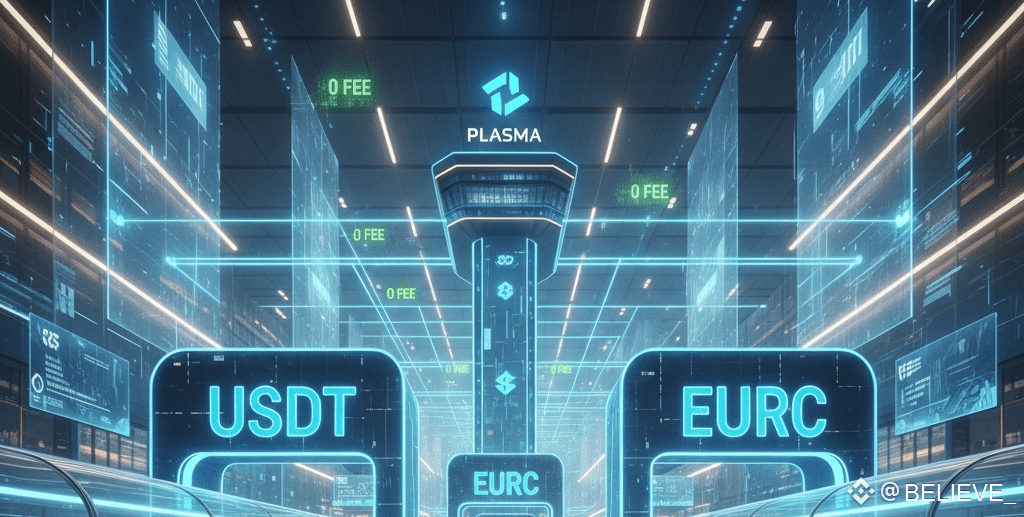 Imagine a busy international airport where people from all over the world arrive with different currencies. At most crypto “airports,” you still need a special token just to walk through the gates, pay for baggage, or use the Wi‑Fi. It feels complicated for something that should be simple.@Plasma shows up with a different approach: what if the stablecoin you already hold could pay for almost everything, and the airport just worked quietly in the background?
Imagine a busy international airport where people from all over the world arrive with different currencies. At most crypto “airports,” you still need a special token just to walk through the gates, pay for baggage, or use the Wi‑Fi. It feels complicated for something that should be simple.@Plasma shows up with a different approach: what if the stablecoin you already hold could pay for almost everything, and the airport just worked quietly in the background?
For years, stablecoins have carried a strange contradiction. On paper, they are meant to be the most “usable” form of crypto—values pegged to real money, easy to understand, less volatile than typical tokens. In practice, using them day to day feels rough. You want to send a small amount, but the gas fee on the underlying chain is high. You want to integrate stablecoins into a business, but the regulatory picture is foggy. You end up juggling networks, worrying about compliance, and still needing a separate token only to pay fees. Stablecoins promise simplicity but often deliver friction.
Plasma is built to smooth that entire experience. It does not treat stablecoins as a side character in a DeFi story. It treats them as the main act. The chain is designed around one clear idea: stablecoins should move like real digital cash—fast, cheap, and understandable to normal people and institutions. That means thinking not just about block times, but about regulations, custody, cards, ramps, and all the invisible things that make payments work in the real world.
One of the boldest things Plasma does is remove gas fees from the user’s sight for key stablecoin transfers. Instead of asking everyone to hold a native token just to move USDT, Plasma uses a paymaster model. In simple terms, the network itself covers gas for certain transactions, so when you send stablecoins, you see “zero gas.” Underneath, the economics and incentives are handled by the protocol and its infrastructure. On the surface, you send 10 units and the other person gets 10, without you worrying about topping up some other coin first.
Plasma’s architecture is tuned for this kind of usage. Blocks are fast, confirmations are quick, and fees—when they do appear—are predictable and low. The consensus design (such as PlasmaBFT) focuses on finality and throughput that make sense for payments rather than speculative bursts. It also allows gas to be paid in multiple currencies, including stablecoins, which reinforces the feeling that stablecoins are truly native to the network, not guests forced to follow old rules.
Where Plasma becomes especially interesting is in its relationship with regulation. Instead of trying to exist in a grey zone, it leans into compliance. Licenses, regulated entities, proper custody, and transparent audits are not seen as optional extras but as part of its core stack. The goal is not only to attract DeFi users but also businesses, fintechs, and institutions that need to answer to regulators. For them, a chain that thinks about KYC, reporting, and consumer protection from the beginning is far more appealing than one that only adds those layers later.
From a user’s perspective, this opens many doors. Imagine getting paid in stablecoins on Plasma and having direct options to spend them via a digital card, withdraw to a bank, or send to a friend—without carefully reading gas charts every time. Or think of a small online shop in Europe that accepts stablecoin payments settling on Plasma, confident that the chain operates under clear legal frameworks. The user does not need to memorize these frameworks; they just benefit from a system designed to not break when it meets the real world.
Of course, none of this automatically guarantees success. A chain can secure licenses and design clever fee models and still struggle if daily usage does not grow. Big initial liquidity—like billions in locked stablecoins—can look impressive on launch dashboards, but if people are not actually sending, spending, and integrating those stablecoins into products, the energy fades. Plasma carries that risk too. It has to convert early interest into real, recurring activity.
There is also the weight of its own ambition. Managing full payment rails—settlement, custody, ramps, cards—while staying compliant is a heavy lift. Every new jurisdiction adds complexity. Every partnership requires careful alignment. If mismanaged, the regulatory and operational overhead could slow down the very agility that makes crypto attractive.
Yet the vision remains compelling. A network where cross-border freelancers can receive stablecoin salaries without losing value to fees. Where families can send remittances that arrive in seconds instead of days. Where fintech apps plug into Plasma as a backend and users barely realize they are touching a blockchain at all. The chain becomes a kind of invisible road system: solid enough to trust, quiet enough to forget, always there when value needs to move.
In the long run, #Plasma is not trying to be the loudest DeFi playground or the most experimental environment. It is trying to be the boring but beautiful backbone—the place where stablecoins stop acting like speculative chips and start acting like money. If it works, people will not talk about Plasma every day. They will talk about how easy it is to pay, get paid, and build financial products on top of stable value that finally behaves the way its name suggests: stable, useful, and always ready to move.


